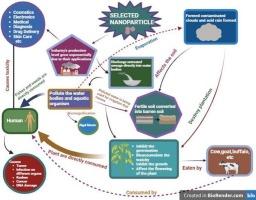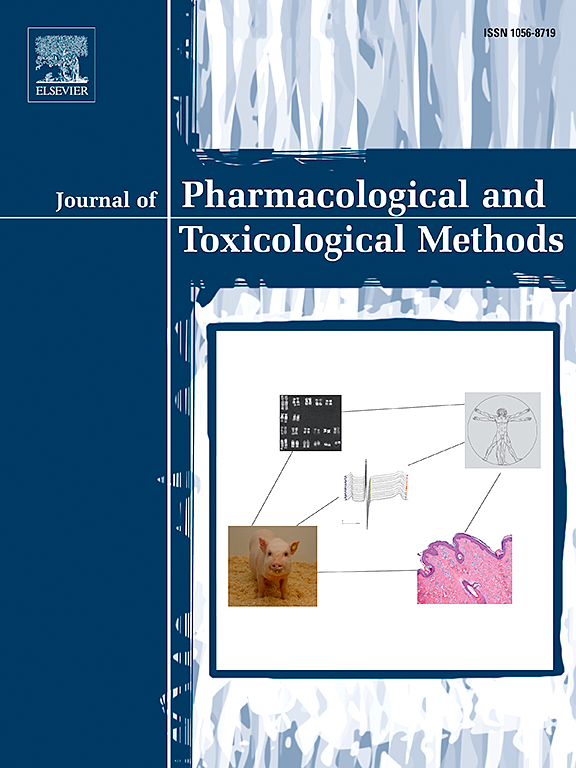Comparative toxicity assessment of selected nanoparticles using different experimental model organisms
IF 1.3
4区 医学
Q4 PHARMACOLOGY & PHARMACY
Journal of pharmacological and toxicological methods
Pub Date : 2024-09-30
DOI:10.1016/j.vascn.2024.107563
引用次数: 0
Abstract
Nanoparticles are microscopic particles ranging in size from one to one hundred nanometers. Due to their extensive features, nanoparticles find widespread use in various fields worldwide, including cosmetics, medical diagnosis, pharmaceuticals, food products, drug delivery, electronic devices, artificial implants, and skincare. However, their unique characteristics have led to high demand and large-scale manufacturing, resulting in adverse impacts on the environment and bioaccumulation. Researchers have been exploring issues related to the environmental toxicity resulting from the high production of selected nanoparticles. This review discusses and addresses the adverse impacts of highly produced nanoparticles such as Carbon Nanotubes, Silica, Titanium dioxide, Zinc Oxide, Copper oxide, and Silver nanoparticles on different in vivo, in vitro, alternate invertebrate models, and plant models. Summarizing in vivo research on rats, rabbits, and earthworms, the review reveals that nanoparticles induce cytotoxicity, embryotoxicity, and DNA damage, primarily targeting organs like the brain, liver, kidney, and lungs, leading to nephron, neuro, and hepatotoxicity. Studying the effects on alternative models like zebrafish, Caenorhabditis elegans, Drosophila, sea urchins, and Saccharomyces cerevisiae demonstrates genotoxicity, apoptosis, and cell damage, affecting reproduction, locomotion, and behavior. Additionally, research on various cell lines such as HepG2, BALB/c 3 T3, and NCL-H292 during in vitro studies reveals apoptosis, increased production of reactive oxygen species (ROS), halted cell growth, and reduced cell metabolism. The review highlights the potentially adverse impacts of nanoparticles on the environment and living organisms if not used sustainably and with caution. The widespread use of nanoparticles poses hazards to both the environment and human health, necessitating appropriate actions and measures for their beneficial use. Therefore, this review focuses on widely used nanoparticles like zinc, titanium, copper, silica, carbon nanotubes, and silver, chosen due to their environmental toxicity when excessively used. Environmental toxicity of air, water, and soil is evaluated using environmentally relevant alternative animal models such as Drosophila, zebrafish, earthworms, etc., alongside in vivo and in vitro models, as depicted in the graphical abstract.

利用不同的实验模式生物对选定的纳米粒子进行毒性比较评估。
纳米粒子是一种尺寸从一纳米到一百纳米不等的微小颗粒。由于其广泛的特性,纳米粒子被广泛应用于全球各个领域,包括化妆品、医疗诊断、药品、食品、药物输送、电子设备、人工植入物和护肤品等。然而,纳米粒子的独特特性导致了对其的大量需求和大规模生产,从而对环境和生物累积产生了不利影响。研究人员一直在探索与大量生产特定纳米粒子导致的环境毒性有关的问题。本综述讨论并探讨了大量生产的纳米粒子(如碳纳米管、二氧化硅、二氧化钛、氧化锌、氧化铜和银)对不同的体内、体外、交替无脊椎动物模型和植物模型的不利影响。该综述总结了对大鼠、兔子和蚯蚓的体内研究,揭示了纳米粒子会诱发细胞毒性、胚胎毒性和 DNA 损伤,主要针对脑、肝、肾和肺等器官,导致肾脏、神经和肝脏中毒。对斑马鱼、秀丽隐杆线虫、果蝇、海胆和酿酒酵母等替代模型的影响研究表明,基因毒性、细胞凋亡和细胞损伤会影响生殖、运动和行为。此外,对 HepG2、BALB/c 3 T3 和 NCL-H292 等多种细胞系进行的体外研究表明,这些细胞系会出现细胞凋亡、活性氧(ROS)生成增加、细胞生长停止和细胞新陈代谢降低等现象。综述强调了纳米粒子如果不能可持续地谨慎使用,可能会对环境和生物体造成不利影响。纳米粒子的广泛使用会对环境和人类健康造成危害,因此有必要采取适当的行动和措施来有益地使用它们。因此,本综述将重点关注锌、钛、铜、二氧化硅、碳纳米管和银等广泛使用的纳米粒子,选择这些纳米粒子是因为它们在过度使用时具有环境毒性。如图所示,本综述使用果蝇、斑马鱼、蚯蚓等与环境相关的替代动物模型,以及体内和体外模型,对空气、水和土壤的环境毒性进行了评估。
本文章由计算机程序翻译,如有差异,请以英文原文为准。
求助全文
约1分钟内获得全文
求助全文
来源期刊

Journal of pharmacological and toxicological methods
PHARMACOLOGY & PHARMACY-TOXICOLOGY
CiteScore
3.60
自引率
10.50%
发文量
56
审稿时长
26 days
期刊介绍:
Journal of Pharmacological and Toxicological Methods publishes original articles on current methods of investigation used in pharmacology and toxicology. Pharmacology and toxicology are defined in the broadest sense, referring to actions of drugs and chemicals on all living systems. With its international editorial board and noted contributors, Journal of Pharmacological and Toxicological Methods is the leading journal devoted exclusively to experimental procedures used by pharmacologists and toxicologists.
 求助内容:
求助内容: 应助结果提醒方式:
应助结果提醒方式:


